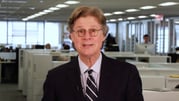by Kevin Mooney
| August 04, 2019 12:00 AM
Instead of focusing on their philosophical and historical differences, American Catholics and Protestants should unite to confront common enemies who jeopardize their religious freedom, the director and producer of a new film about the Cold War argues.
What ultimately brought down the Soviet Union was not some natural process of osmosis, Robert Orlando explained in an interview. Despite its hostility to human freedom and its flawed economics, Russia’s Marxist-Leninist system had to be pushed and challenged internally and externally by men and women with strong Christian convictions, he told me.
The Divine Plan, which can be described as part documentary and part stage play, tells the story of the partnership between the Reagan White House and the Vatican under Pope John Paul II. The strong friendship that emerged between the Protestant president and the Catholic pope figures prominently in the story telling.

Chief Political Correspondent Byron York on the expanded Washington Examiner magazine
Orlando, the president and director of Nexus Media, a Princeton, New Jersey-based filmmaking studio, drew in several key figures familiar with the Reagan era to tell the story. He is also the co-author of a book version of the film with Paul Kengor, a Grove City College political science professor and noted Reagan biographer. The example set by the pope and the president in the final dramatic moments of the Cold War is instructive to today’s challenges, Orlando suggests.
“We have bigger enemies today than the Protestant-Catholic divide,” he said. “I think one of the lessons set by the example of Pope John Paul II and Ronald Reagan for today is for Christians to avoid splintering off into too many groups to the point where they fail to find a collective moral core. I think for millennials especially, there’s a danger of them seeing themselves as individually in charge of their own morality to the point where it becomes very hard for them to become part of community and to put up a united front.”
The book version, like the movie, discusses the “many parallels” between the two men that brought them together at a critical moment in history. The film also takes a deeper dive into the origins and unique features of their character.
The Protestant president and Catholic pope were both the victims of assassination attempts that took place just six weeks apart in 1981. They were also both former actors with a strong stage presence, and they both experienced childhood loss and trauma. But above all else, they both believed they had been called to take part in a “divine plan” and that they had been spared from the assassination attempts for this reason.
Reagan drew from the Protestant faith of his mother Nelle Reagan. But his father was Catholic, and Reagan maintained close associations with many prominent Catholics throughout his political career. These key figures include William Casey, Reagan’s CIA director, William Clark, a longtime adviser to Reagan, Richard Allen, a national security adviser, and Vernon Walters, a retired Army general who was Reagan’s second ambassador to the United Nations. These individuals all played a role in fostering ties between the Reagan White House and the Vatican, Orlando said. He also points out that it was Reagan who restored full diplomatic tieswith the Vatican for the first time in 117 years.
But before the partnership between the pope and the president could take shape, Orlando found in his research that Reagan initially had to break through the hostile press coverage of the U.S. media.
“John Paul II was suspicious of Reagan at first,” Orlando said. “Although he wanted to meet with the American president and come away with an optimistic perspective, he was suspicious because even the pope was taken in by the Western media. But the pope later remarked after meeting Reagan, that he saw he was a man of peace and once he knew that the flood gates were open. He was not the warmonger the media portrayed him as.”
The film will likely open new areas of inquiry since many historians have until now overlooked the role Reagan’s Christian faith and religious thought had on a unified vision for public policy and on his relationship with the Vatican, Orlando said.
Bishop Robert Barron, founder of Word on Fire Catholic Ministries and auxiliary bishop of the Archdiocese of Los Angeles, is among the sources cited in the book who also appears in the film to discuss the unheralded aspects of the relationship between Pope John Paul II and Reagan on the world stage.
“Bishop Barron is an eclectic thinker who has personally processed everything he’s thought about,” Orlando said. “He’s incredibly articulate about the way to deliver his remarks and can see all the relevant points of view. It’s a rarity for someone to be able to do this and still hold to his own core convictions and especially from a Catholic perspective. So, he was liberating for me. It meant if I wanted to go New Testament he was there, it meant if I wanted to go Catholic theology, he was there. If I wanted to get into atheistic thinking, he was there. If I wanted to get into my narrative, he could go there. In fact, there was no place I couldn’t go with him.”
Upcoming screenings for The Divine Plan will happen across the country this fall.
Orlando’s great hope is that the historical example set by Reagan and Pope John Paul II inspires Catholics and Protestants to become more cognizant of their shared values and convictions.
Kevin Mooney (@KevinMooneyDC) is a contributor to the Washington Examiner's Beltway Confidential blog. He is an investigative reporter in Washington, D.C. who writes for several national publications.
Source

No comments:
Post a Comment